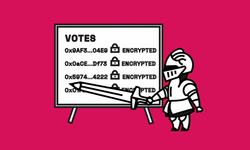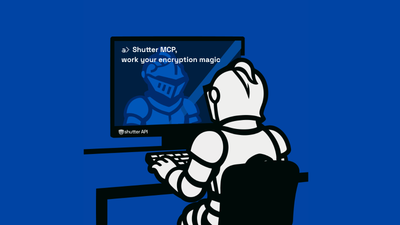If you’re running a decentralized exchange (DEX) with a centralized order book operator, managing an OTC trading platform, or developing an on-chain derivatives protocol with a trusted execution party, then you already know how Maximal Extractable Value (MEV) attacks can wreak havoc on your users. High-volatility, low-liquidity token markets are especially vulnerable. Shutter API provides a practical solution through Shielded Trading, using threshold encryption to eliminate trust in centralized trading entities and protect users from front-running and sandwich attacks - without requiring protocol-level changes.
This solution complements broader innovations like in-protocol encrypted mempools, which we’ve successfully deployed on Gnosis Chain. Unlike protocol-level encrypted mempools that enhance MEV protection directly within the blockchain, Shutter API specifically targets centralized or semi-centralized trading setups, providing immediate, flexible, and seamless integration without changing underlying protocols.
MEV Exploits Faced on DEXs, OTC Deals, and Derivatives
Every type of on-chain trade is vulnerable if transaction details are exposed in the public mempool. Let's examine MEV exploits across different domains:
- DEX Swaps and Liquidity Pool Trades: In March 2025, a trader looking to swap a large amount of stablecoins on Uniswap v3’s USDC-USDT liquidity pool suffered a catastrophic sandwich attack. They attempted to trade about $220,000 of USDC for USDT in a low-liquidity pool - and a bot exploited the trade by manipulating liquidity. The bot momentarily withdrew most liquidity from the pool before the swap, causing the trader’s order to execute at an extreme rate. In 8 seconds, the trader got only $5,271 out of ~$220k - losing 98% of their money to the attacker. The MEV bot paid a huge bribe to the block builder (around $200k) to secure this sandwich, and walked away with profit, while the user was virtually wiped out. Unfortunately, this wasn’t an isolated case; a similar attack earlier turned a $732,000 swap into just $19,000 for the victim. These incidents underscore that even swapping “safe” assets like stablecoins can be unsafe on a public mempool. All it took was a bot seeing the large order in advance and exploiting the liquidity gap.

- Private OTC Trading & Large Order Execution: Over-the-counter deals are meant to occur off-exchange to avoid slippage and market impact. However, when such deals are settled on-chain, they broadcast the trade details to everyone. If you try to sell a large position in a low-cap token in one go, you’re effectively alerting bots to you. They might front-run by shorting or dumping that token knowing your sell will tank the price, or back-run by scooping up the cheap tokens after your sale. In one notable case, the founder of a DeFi protocol had to conduct a series of small OTC sales to repay a loan rather than one big trade - doing it piecemeal was the only way to avoid tipping off the market and getting preemptively dumped on by opportunists. The lesson is clear: any large on-chain trade, if visible beforehand, invites exploitation. OTC desks might try to use dark pools or break up orders, but on a transparent blockchain, “private” deals aren’t really private unless block trade settlements remain confidential until they are finalized.
- On-chain derivatives and options protocols: It’s not only spot token trades that MEV bots target. Derivatives platforms - such as perpetuals, futures, and options protocols - are also vulnerable to transaction-based manipulation. For example, when a user opens a large leveraged position or submits an options trade with a visible strike price, that intent is exposed in the public mempool. Bots monitoring pending transactions can react by front-running the trader, pushing the price against them, or manipulating related AMM pools or oracles to skew execution. In some cases, a bot may detect a long position about to execute and buy up the underlying asset to inflate the price, forcing the trader to enter at a worse rate, then sell after execution to capture a profit. With options, bots can exploit predictable strike levels by distorting the underlying price just before expiry or execution. These strategies are often difficult to detect on-chain but stem from the same root cause: visibility of trade intent before execution. Without transaction privacy, high-leverage and high-sensitivity trades become easy targets.
Other MEV Solutions Attempt to Provide Protection, But Fall Short
Given the scale of malicious MEV, the community hasn’t been idle. Various mitigation strategies have been developed to protect users from front-running and sandwich attacks. Perhaps you or your users have tried some of these. And to a degree, they can reduce exposure. But they all come with trade-offs.
Popular tools, like Flashbots Protect, MEV-Boost, and RPC-based services such as Eden Network or Blocknative, promise protection by routing transactions through private, trusted infrastructure. These systems claim to safeguard your data and prevent it from being leaked or exploited. But here’s the catch: you still have to trust them.
These relays and RPCs are closed systems. Users can’t see what happens inside. And if a multi-million-dollar MEV opportunity appears, there’s no way to verify that the operator didn’t take advantage of it. At the end of the day, you’re still relying on a centralized actor with privileged access. The interface might look different - but the underlying trust model hasn’t changed.
And what happens when a transaction carries a high-value MEV opportunity? The answer is simple: if it’s visible, it will be taken.
These solutions don’t eliminate the problem. They just shift the point of trust, hoping that new visibility custodians will behave better than the last.
Some MEV mitigation approaches go further, relying on hardware-based solutions like Trusted Execution Environments (TEEs). These secure enclaves are designed to privately process data even on compromised systems. In theory, your transaction is safe - encrypted, executed securely, and hidden from even the operator.
But again, this depends on trust - this time in a hardware vendor. And if that trust is broken, the entire system is compromised.
For any platform relying on these MEV mitigation solutions, this should be an alarming realization: none of them solve the core issue.
That’s why Shutter exists - to eliminate the problem at its root.
Instead of hiding your transaction behind another trusted party, Shutter encrypts it so that no one - not a relay, not a sequencer, not a miner - can see what’s inside until it’s irreversibly committed to a block
There’s no visibility. Which means there’s no opportunity for exploitation.
How Shutter API Enables Shielded Trading
The Shutter API provides decentralized threshold encryption to prevent transaction details from being visible until execution. It's ideal for financial use cases involving centralized or semi-centralized components like DEXs with central order book operators, or OTC desks settling transactions on-chain.
Here’s how it would work step-by-step:
- Commit (encrypted submission): When users submit a transaction via your centralized operator, the transaction payload is encrypted using Shutter’s public encryption key. Users still interact normally, but the transaction content remains hidden from the operator and other potential attackers.
- Ordering and Commitment: The centralized order book operator sequences encrypted transactions based on pre-defined logic (such as order arrival or fees). Transactions are committed publicly in encrypted form, preventing front-running and malicious reordering.
- Threshold Decryption and Execution: A decentralized group of nodes (Keypers) collaboratively decrypts the transactions only after the transaction ordering is finalized. No single party, including the centralized operator, can decrypt transactions alone. This prevents exploitation at the point of transaction finalization.
- Post-trade Outcome: Transactions execute exactly as intended, free from front-running or sandwich attacks. Users benefit from fair execution with no unexpected slippage or manipulation.
How Shutter API Fixes MEV Exploits in DEXs, OTC Deals, and Derivatives
Here’s an overview of the what Shielded Trading delivered by Shutter API can provide:
- DEXs and Liquidity Pool Trades: Shutter API eliminates sandwich attacks by encrypting swaps until execution. Bots can no longer detect large trades in the mempool, front-run them, or manipulate slippage through liquidity shifts. Traders receive fairer execution, and liquidity providers are protected from toxic order flow. For DEX protocols, this creates a more secure and manipulation-resistant trading environment - especially in low-liquidity or high-volatility markets.
- Private OTC Trading & Large Order Execution: Large traders and institutions often avoid on-chain execution due to front-running and price impact. Shutter API allows block trades and rebalances to be submitted discreetly. Asset type, trade size, and direction remain fully hidden until settlement, preventing market reactions and preserving execution quality. This unlocks safer, more efficient OTC settlement on public chains.
- Derivatives Protocols: Derivatives platforms are especially vulnerable to MEV. Exposed strike prices, leverage positions, or time-sensitive orders can be manipulated through oracle timing or price distortion. Shutter API keeps all trade parameters encrypted until execution, preventing bots from interfering. This ensures that strategies remain private and positions are protected until they settle.
It’s Time to Shield Your Users - Integrate Shutter API for Shielded Trading
Front-runners and sandwich bots have been attacking users for long enough. If you’re a DEX developer, an OTC platform operator, or building the next big DeFi derivatives protocol, protecting your users from malicious MEV is a must-have for credibility and success.
- Learn more about Shutter API
- Schedule a Shutter API demo with the Shutter team
- Explore the docs for Shutter API use cases across DEXs, OTCs, and derivatives trading









